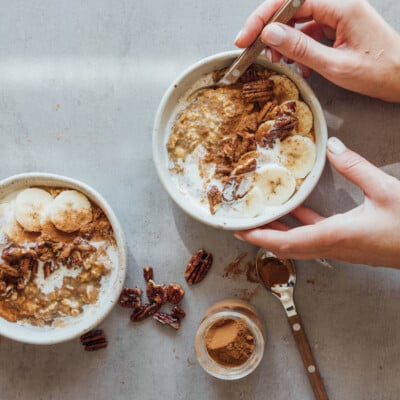ed note: Though January is drawing to a close, our team is still working hard on our resolutions and focusing on making small changes to improve our surroundings. For many of us, the areas most in need of TLC are in our homes, or more specifically, our well-loved kitchens. So we turned to fellow Austinite, wellness enthusiast, and co-founder of Branch Basics, Allison Evans to help us break down the steps of getting our kitchens squeaky clean, while leaving all those harmful toxins out of the picture. Take it away, Allison!
If “clean” means “free of contaminates, unadulterated, pure”, why do we typically associate a kitchen scrub-down with rubber gloves, the smell of ammonia and a possible headache? After my own dramatic brush with toxic chemicals, I got the help of my aunt (a highly sought-after healthy living consultant) and my best friend to start making truly safe cleaning solutions that (we think) work better than the conventional ones. Through Branch Basics, we are committed to ridding the world of synthetic chemicals – one kitchen and two little hands at a time.
Let’s face it: no matter the size, layout or lure of our spaces, we all end up in the kitchen. So what if you didn’t have to use even a drop of toxic chemicals to keep things clean? I’ve thrown away the old rules for deep cleaning, and created a new guide to getting your kitchen truly clean. So remove those rubber gloves and get started!
*photography by Kate Zimmerman for Branch Basics

Oven. Instead of baking harsh chemicals into your oven, try this method: Preheat on the lowest setting and then turn the oven off. Spray liberally with the Branch Basics soap solution (more soap may be needed), let sit for 20 minutes, then scrub with a natural bristled brush (I like this one from Full Circle). Wipe with a microfiber cloth. You can also mix a 1:3 solution of baking soda to warm water, using the paste to scrub away old scum. Repeat if necessary.
Stove. For a gas range, remove and set aside burner caps, grates and knobs. For a coil electric stovetop, remove the heating elements, the knobs and drip pans. Spray the parts and stovetop liberally with the soap solution and let it sit 5-10 minutes. This is where I really plug Branch Basics because its powerful enzyme action breaks down old grease and grime. Rinse and dry the parts and stovetop and reassemble! For a smooth electric stovetop, simply spray the soap solution, let sit and wipe clean.
Allison’s Pro Tip: Use real soap, not synthetic foamers, dyes and fragrance.
Good news: The Center for Disease Control agrees that soap and water can tackle even the toughest jobs, but quality matters! I love Branch Basics Cleaning Soap for its purity, versatility and ability to tackle grease and scum like none other. An alternative is a pure castile soap like Dr. Bronner’s. For this option, fill a 32 oz spray bottle with water and 2 T of soap (too much soap will require rinsing).

Refrigerator. Remove everything first – you won’t regret it! Spray liberally with the soap solution and wipe with a microfiber cloth. Leave an opened box of baking soda in the fridge for deodorizing.
Freezer. Remove all items from the freezer and place in a cooler for temporary storage. Unplug the refrigerator, then spray liberally with the soap solution and wipe with a microfiber cloth.

Cutting Boards and Butcher Blocks. Spray cutting boards or the butcher block with the soap solution, let sit a few minutes and rinse. Alternately, sprinkle the surface with salt and rub a lemon half across it, letting it sit a few minutes before scrubbing and rinsing. We recommend doing this after each use.
Allison’s Pro Tip: Use food-grade cleaning products.
When using a conventional disinfectant, you leave behind a trail of synthetic residue and/or pesticides… not the best side to a freshly-prepped meal! Instead, find products that you feel confident using around your food, or incorporate pantry staples like salt, lemon, baking soda or vinegar.

Surfaces and Cabinets. Use the soap solution and spray countertops, appliances, tables – even walls, inside drawers and cabinets. Wipe with a microfiber cloth.
Allison’s Pro Tip: Ask your kids for help.
Don’t let your chores turn the house into a kid-free chemical zone. When you use human-safe products, your kids can happily pitch in – I’ve found they love cleaning!

Dishes. Here’s my secret tip on cleaning a sink full of dishes: Spray down the particularly messy ones with your soap solution and let them sit a few minutes. (This is where Branch Basics’ plant enzymes really shine!) For the greasiest and most food-hardened dishes and pans, take a few minutes to enjoy a glass of wine or cup of coffee, then come back to easily rinse them clean!

Allison’s Pro Tip: Throw away the rubber gloves.
Good, non-toxic soap shouldn’t leave your hands chapped and doesn’t require ventilation. When you are using soaps with safe oil bases (olive oil, coconut oil, or other plant-based oils) and truly pure ingredients, you are able to preserve the natural oil balance of your skin.

Enamel Sink. Spray the sink with the soap solution and sprinkle liberally with a natural scouring agent like Bon Ami. Let it sit 10 minutes and watch scuffs and scratches disappear with a little rubbing.

Floors. HEPA vacuum or sweep floor first, then damp mop with a diluted version of the soap solution (about 2 T to 1 gallon water).
Allison’s Pro Tip: Forget about the “clean” smell.
Those “clean” scents we grew up with? Guess what: no relation to pine trees and orange peels. If you really like a fragrance, add 10-20 drops of a high-quality essential oil or a Branch Basics food-grade scent oil to your soap solution. My favorites are lavender and peppermint (avoid lemon and grapefruit essential oils, as they may react and create dangerous particulates when cleaning).




